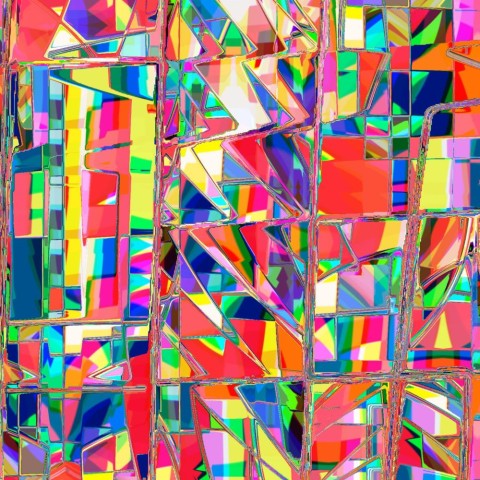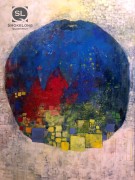This morning, the window pane is frosted over and Wei’s gone again. When I draw his reflection on the glass, I add an AR emoji of googly eyes and fiery eyebrows. He loves it when I do that. I imagine him packing in the dark before he left, skulking in order not to wake me. On the side table is his note, all the hand-written alphabets shivering against each other because he has no faith in capital letters: off to lonesome hill, back in two weeks. Is Lonesome Hill imagined geography – what portentous names! – Agony Peninsula, Desperate Strait. Well, no chicken lo mein for him for two weeks, he won’t like that.
I first met Wei at his exhibition, ‘woebegone places’. He’d painted aerial topologies and named them Sorrow Island, City of Disappointment, Trench of Failure, a headland called The Point of No Return. All morose-sounding places, as if they were somebody’s idea of a doleful prank. Or was it a way to turn things around; like a Chinese superstition, you call your baby ugly because only then will it grow up beautiful. When I turned around, there Wei was, looking at me from across the room.
I told him my favourite painting of his was a street intersection: Heart’s Desire and Broken Hearts Lane. A double heart, like the Chinese character double happiness – 囍 . Wei threw back his champagne and said people who fetishised the heart are bound to end up in these abstracted geographies, places on earth where other people with a tragicomic sense of failure try to amuse themselves.
He said, have a look at the Chinese names, translations for the West often demand such Eastern piquancy.
I did. He was right, their Chinese names were less melancholic-sounding.
Wei loves maps; he pores over them, collecting names like stamps, marking their landscapes on Gambi. Painting them in child-like swirls, drips and lines. White-tipped waves, brown studs of land, green foliage lines.
That was four years ago. Together. Four years. Over time, by dribs and drabs, I learned that when he was little, he often misbehaved. As punishment, his mother stuffed him into a waist-high porcelain urn. There, he dreamt up places called Terrible Mountain and Valley of Punitive Gloominess. A stunted pine tree sat on a ridge in the distance; he could see it over the rim of the urn. Humpback Pine, he named it. When he was thirty, the pine got struck down by lightning. He began his woebegone series. He called it his Yayoi Kusama epiphany; she painted dots to infinity, he dotted landscapes. His compulsion to serenity. If you paint the same thing often enough, it loses power over you.
A year ago, he discovered a place called Distress Gorge. A real place he had to see for himself. He said he would return in a week, but didn’t come home for five. When he came back, he brought me a totem, a wooden woman with huge breasts and hips, a hole in her pubis. He locked her up in his studio. I was allowed in only to wipe her down.
His sudden disappearances began shortly thereafter. His notes of return were unreliable guides. Waiting, I fill my days with gardening. If I’m not planting the flower beds, I’m weeding or in the shed with the bulbs, seeds and potted soil. I sneak into his studio and fill the hole in the wooden woman full of sunflower seeds.
Wei comes home with another totem woman. In bed, he claws, marks, carves an emotive trail with lips and tongue, poking at the topography of my body, my breasts which he calls Twin Peaks of Harmony, my belly button The Vortex of Fluff, my lips the Drunken Cave, my vagina The Tunnel of Doom. I slip in a diaphragm and call it my Jade Gate. As if possessed, he tries to gain entrance with fingers and tongue, and we decide The Tunnel of Doom needs a more auspicious name.
When he leaves again, he calls me from a town called Abandon, its name reverberating like a Swiss alpine yodel, the wind shrieking into the phone. Wei screaming against it, guess what, Seattle is only a 15-min helicopter ride away, I imagine Wei hopping nimbly into the cabin, shouting to the pilot that he needs a Starbucks iced caramel latte pronto.
He brings back another totem. A witch-woman, all long tresses and scary bug-eyes; her lip flows past her neck like an elongated gully. Bless-me-Mother, I call her, because every time I walk past, I feel that she carries a curse of secret knowledge that seeps into all the nooks and crannies, the spaces in between.
The call comes in the middle of the night. Wei is in a small-town hospital in a place called Ruinous Cove. He broke his collarbone falling out of a tree while trying to photograph some dwellings on a hill. Oh, he also broke his leg in two places and it will take some time to heal. Chinese Icarus has been brought down, he jokes.
I don’t go see him in the hospital; there’s no need, his gallery has hired him a private nurse. When he’s ready to come home, I’ll prepare his studio for him, covering the unfinished canvasses with white cloths. His three totemic women sculptures though, I’ll stand them in a row just by the door, wearing weaved flower-tiaras and hula skirts, his very own harem welcome home party.
He’s in a wheelchair when I see him, crutches on the ready. I sit and take his hand, hardened and skinned in patches, the veins blue like tributaries. Something broke, qing ai de, he said. No more climbing for me. It broke way back when, but what’s the point of naming things? With a Bic, I draw him a beach scenescape: fat coconuts, swinging hammock, stick children flying kites. See how they heel it to the outer edges of taxonomic brokenness.

Notes from Guest Reader Ron A. Austin
In ‘A Map of Woebegone Places’, Elaine Chiew masterfully blends high concept, humor, and compassion.


 The core workshop of SmokeLong Fitness is all in writing, so you can take part from anywhere at anytime. We are excited about creating a supportive, consistent and structured environment for flash writers to work on their craft in a community. We are thrilled and proud to say that our workshop participants have won, placed, or been listed in every major flash competition. Community works.
The core workshop of SmokeLong Fitness is all in writing, so you can take part from anywhere at anytime. We are excited about creating a supportive, consistent and structured environment for flash writers to work on their craft in a community. We are thrilled and proud to say that our workshop participants have won, placed, or been listed in every major flash competition. Community works.